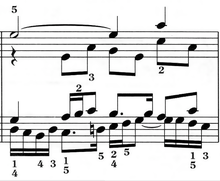Melody

Amelody(fromGreekμελῳδία(melōidía)'singing, chanting'),[1]alsotune,voiceorline,is a linear succession ofmusical tonesthat the listener perceives as a single entity. In its most literal sense, a melody is a combination ofpitchandrhythm,while more figuratively, the term can include other musical elements such astonal color.It is the foreground to the backgroundaccompaniment.A line orpartneed not be a foreground melody.
Melodies often consist of one or more musicalphrasesormotifs,and are usually repeated throughout acompositionin various forms. Melodies may also be described by theirmelodic motionor the pitches or theintervalsbetween pitches (predominantlyconjunct or disjunctor with further restrictions), pitch range,tensionand release, continuity and coherence,cadence,and shape.
Function and elements
[edit]Johann Philipp Kirnbergerargued:
The true goal of music—its proper enterprise—is melody. All the parts of harmony have as their ultimate purpose only beautiful melody. Therefore, the question of which is the more significant, melody or harmony, is futile. Beyond doubt, the means is subordinate to the end.
— Johann Philipp Kirnberger (1771)[2]
The Norwegian composerMarcus Paushas argued:
Melody is to music what a scent is to the senses: it jogs our memory. It gives face to form, and identity and character to the process and proceedings. It is not only a musical subject, but a manifestation of the musically subjective. It carries and radiates personality with as much clarity and poignancy as harmony and rhythm combined. As such a powerful tool of communication, melody serves not only as protagonist in its own drama, but as messenger from the author to the audience.
— Marcus Paus(2017)[3]
Given the many and varied elements and styles of melody "many extant explanations [of melody] confine us to specific stylistic models, and they are too exclusive."[4]Paul Narveson claimed in 1984 that more than three-quarters of melodic topics had not been explored thoroughly.[5]
The melodies existing in most European music written before the 20th century, and popular music throughout the 20th century, featured "fixed and easily discernible frequencypatterns",recurring" events, often periodic, at all structural levels "and" recurrence of durations and patterns of durations ".[4]
Melodies in the20th century"utilized a greater variety of pitch resources than ha[d] been the custom in any other historical period ofWesternmusic."While thediatonic scalewas still used, thechromatic scalebecame "widely employed."[4]Composers also allotted a structural role to "the qualitative dimensions" that previously had been "almost exclusively reserved for pitch and rhythm". Kliewer states, "The essential elements of any melody are duration, pitch, and quality (timbre),texture,and loudness.[4]Though the same melody may be recognizable when played with a wide variety of timbres and dynamics, the latter may still be an "element of linear ordering."[4]
Examples
[edit]

Differentmusical stylesuse melody in different ways. For example:
- Jazzmusicians use the term "lead" or "head" to refer to the main melody, which is used as a starting point forimprovisation.
- Rock music,and other forms ofpopular musicandfolk musictend to pick one or two melodies (verseandchorus,sometimes with a third, contrasting melody known as abridge or middle eight) and stick with them; much variety may occur in the phrasing andlyrics.
- Indian classical musicrelies heavily on melody andrhythm,and not so much onharmony,as the music contains no chord changes.
- Balinesegamelanmusic often uses complicated variations and alterations of a single melody played simultaneously, calledheterophony.
- In westernclassical music,composersoften introduce an initial melody, ortheme,and then create variations. Classical music often has several melodic layers, calledpolyphony,such as those in afugue,a type ofcounterpoint.Often, melodies are constructed frommotifsor short melodic fragments, such as the opening of Beethoven's Fifth Symphony.Richard Wagnerpopularized the concept of aleitmotif:a motif or melody associated with a certain idea, person or place.
- While in both mostpopular musicand classical music of thecommon practice periodpitch and duration are of primary importance in melodies, thecontemporary musicof the 20th and 21st centuries pitch and duration have lessened in importance and quality has gained importance, often primary. Examples includemusique concrète,klangfarbenmelodie,Elliott Carter'sEight Etudes and a Fantasy(which contains a movement with only one note), the third movement ofRuth Crawford-Seeger'sString Quartet 1931(laterre-orchestratedasAndante for string orchestra), which creates the melody from an unchanging set of pitches through "dissonant dynamics" alone, andGyörgy Ligeti'sAventures,in which recurringphoneticscreate the linear form.
See also
[edit]- Hocket
- Parsons code,a simple notation used to identify a piece of music throughmelodic motion—the motion of thepitchup and down.
- Sequence (music)
- Unified field
References
[edit]- ^μελῳδία.Liddell, Henry George;Scott, Robert;A Greek–English Lexiconat thePerseus Project.
- ^Forte, Allen (1979).Tonal Harmony in Concept & Practice,p. 203.ISBN0-03-020756-8.
- ^Paus, Marcus (6 November 2017)."Why melody matters".Gramophone.
- ^abcdeKliewer, Vernon (1975). "Melody: Linear Aspects of Twentieth-Century Music",Aspects of Twentieth-Century Music,pp. 270–301. Wittlich, Gary (ed.). Englewood Cliffs, New Jersey: Prentice-Hall.ISBN0-13-049346-5.
- ^Narveson, Paul (1984).Theory of Melody.ISBN0-8191-3834-7.
- ^Marquis, G. Weston (1964).Twentieth Century Music Idioms,p. 2. Prentice-Hall, Inc., Inglewood Cliffs, New Jersey.
Further reading
[edit]- Apel, Willi.Harvard Dictionary of Music,2nd ed., pp. 517–19.
- Cole, Simon (2020). just BE here – the guide to musicking mindfulness
- Edwards, Arthur C.The Art of Melody,pp. xix–xxx.
- Holst, Imogen(1962/2008).Tune,Faber and Faber, London.ISBN0-571-24198-0.
- Smits van Waesberghe, Joseph(1955).A Textbook of Melody: A course in functional melodic analysis,American Institute of Musicology.
- Szabolcsi, Bence(1965).A History of Melody,Barrie and Rockliff, London.
- Trippett, David (2013).Wagner's Melodies.Cambridge University Press.
- Trippett, David (2019). "Melody" inThe Oxford Handbook to Critical Concepts in Music Theory.Oxford University Press.
External links
[edit] The dictionary definition ofmelodyat Wiktionary
The dictionary definition ofmelodyat Wiktionary Quotations related toMelodyat Wikiquote
Quotations related toMelodyat Wikiquote- Carry A Tune Week, list of tunes
- Creating and orchestrating a coherent and balanced melodyArchived2021-04-28 at theWayback Machine
